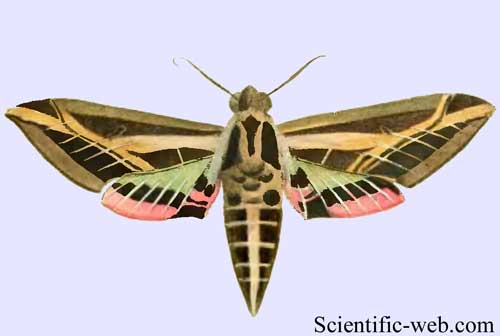
Eumorpha fasciatus
Superregnum: Eukaryota
Cladus: Unikonta
Cladus: Opisthokonta
Cladus: Holozoa
Regnum: Animalia
Subregnum: Eumetazoa
Cladus: Bilateria
Cladus: Nephrozoa
Cladus: Protostomia
Cladus: Ecdysozoa
Cladus: Panarthropoda
Phylum: Arthropoda
Subphylum: Hexapoda
Classis: Insecta
Cladus: Dicondylia
Subclassis: Pterygota
Cladus: Metapterygota
Infraclassis: Neoptera
Cladus: Eumetabola
Cladus: Endopterygota
Superordo: Panorpida
Cladus: Amphiesmenoptera
Ordo: Lepidoptera
Subordo: Glossata
Cladus: Coelolepida
Cladus: Myoglossata
Cladus: Neolepidoptera
Infraordo: Heteroneura
Cladus: Eulepidoptera
Cladus: Ditrysia
Cladus: Apoditrysia
Cladus: Obtectomera
Cladus: Macroheterocera
Superfamilia: Bombycoidea
Familia: Sphingidae
Subfamilia : Macroglossinae
Tribus: Philampelini
Genus: Eumorpha
Species: Eumorpha fasciata
Eumorpha fasciatus, the banded sphinx, is a moth of the family Sphingidae. The species was first described by Johann Heinrich Sulzer in 1776.
Distribution
It is found from northern Argentina, Bolivia, Paraguay, Uruguay, Brazil, Colombia, Ecuador and Peru, north through Central America (Mexico, Belize, Guatemala, Honduras, Nicaragua, Costa Rica and Panama) to southern California and southern Arizona, east to Texas, Louisiana, Mississippi, Florida and South Carolina. Strays can be found north up to Missouri, Michigan, Indiana, Pennsylvania, New Jersey, New York and Nova Scotia. It is also found in the Caribbean.[2]
Description
Male dorsal view
Male ventral view
Biology
Adults are on wing year round in the tropics, but in the north, there are at least two generations with adults on wing from the end of May to July and the end of August to October in South Carolina and from May to October in Louisiana. Adults have been recorded feeding on nectar of Crinum, Catharanthus roseus, Petunia and Saponaria officinalis.
The larvae feed on Ludwigia (including L. decurrens, L. erecta, L. leptocarpa, L. octovalvis, L. peruviana and L. repens), Cissus verticillata, Fuchsia hybrida, Magnolia virginiana, Parthenocissus and Vitis species. The larvae are highly variable in patterning and depth of color. Pupation takes place in burrows.
Subspecies
Eumorpha fasciatus fasciatus
Eumorpha fasciatus tupaci (Kernbach, 1962) (Galápagos Islands)
References
"CATE Creating a Taxonomic eScience - Sphingidae". Cate-sphingidae.org. Archived from the original on 2012-11-13. Retrieved 2011-10-26.
"Eumorpha fasciatus fasciatus". Sphingidae of the Americas. Archived from the original on 2015-05-23. Retrieved 2011-10-26.
Retrieved from "http://en.wikipedia.org/"
All text is available under the terms of the GNU Free Documentation License

